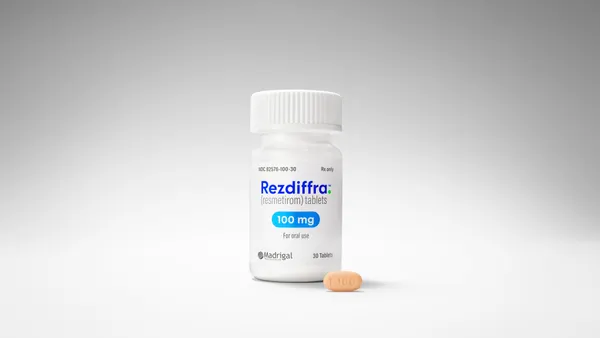In the engine room of a company, leaders and internal experts conceptualize and form direction. The decisions they make determine a company’s success rate. It’s in this capacity that Matt Emmens takes a lead. He knows how to diagnose what’s wrong with the engine and how to get all the components working together. This is a parallel to his life outside the office, where Mr. Emmens also has a knack for all things mechanical: restoring classic cars, boating, and flying an airplane. “My interest in mechanics is a good metaphor for what I like to do in business, which is to find things that need to be fixed, figure out what’s wrong, and get all of the parts work ing together and running well,” he says. But there’s a great deal more to it than that. Mr. Emmens is a business innovator and cre ative thinker, who has proven time and again that he’s not afraid to chart a new course and take a risk to improve how a business operates. At Astra Merck, a joint venture between Astra Pharmaceuticals and Merck that Mr. Emmens helped to establish, he was instrumental in defining what was at the time a new way to operate: a multifunctional team approach. “At the time, this strategy was avantgarde; we were powering business units by allow ing decisions to be made at all levels,” he says. With just four levels throughout the company, Mr. Emmens and Wayne Yetter, then president of the organization, ensured there was equal say across research, development, com mercialization, and manufacturing; decision making was done at a team level. BY KIM RIBBINK DRIVING Success I 52 J un e 2 008 PharmaVOICE PV0608 Layout FINAL2 5/20/08 12:46 AM Page 52 it had an older product line — the aver age product was 15 to 20 years old. When talking about his early career and experience in the industry, Mr. Emmens conveys a genuine sense of pleasure and excitement. “I never had a bad day at Merck; that was a tremendous experience,” he says. “I got to work with a lot of great people in a company that was transforming itself.” The period Mr. Emmens spent at Merck, from 1974 to 1993, was one of significant growth and huge advances in dis covery. “Merck was coming out with many firsts; products were coming one, two, three a year for a decade and it was a really exciting time to be there,” he says. Among these products were the first safe and effective treatment for glaucoma, Timop tic; the first ACE inhibitor for blood pressure, Vasotec; and the first statin for cholesterol, Mevacor. “Fortune magazine named Merck the most admired company for seven years in a row; the company had the most admired salesforce; and several times when I was head of sales training it had the most admired sales training pro gram — that was an amazing series of acco lades,” he says. “The company had access to some of the best people on the planet because of its profile.” Big PICTURE His experiences at Merck gave Mr. Emmens a wellrounded understanding of what is required to achieve success as well as insight into the broader environment in which the lifesciences industry operates. A challenging opportunity emerged when Astra Sweden and Merck decided to enter into a joint venture. Since 1982, Merck had been licensing Astra’s oral products for the U.S. market and the two companies decided to form a freestanding joint venture when sales of those products reached $500 million, Mr. Emmens explains. Merck colleague Mr. Yetter was named pres ident and CEO of that venture in June 1991, and Mr. Emmens joined in November of that year as the second employee. “Wayne and I set up Astra Merck first as a division of Merck and then in 1994 when we exceeded that sales milestone by about $200 million it became a freestanding 5050 joint venture,” he says. MATT Emmens While this has become a popular way to operate in recent years, there was little to no precedent in the life sciences for whether the model would be successful. “This was probably the earliest multifunctional team in pharma; com panies in other industries had done it — Apple, Patagonia, and Saturn — but nobody had done this in our busi ness,” Mr. Emmens says. “Of course, there were naysayers, but we were pretty gungho, and ultimately the strategy worked.” Since taking stewardship of Shire Pharma ceuticals in 2003, Mr. Emmens has been steer ing the company toward greater and greater success, but when he joined the company it had been going through a rocky period, with its stock value slumping from more than $70 a share to about $13 over two years. Today, Shire has a healthy pipeline with about two dozen ongoing projects and has been described by several analysts as having the richest pipeline in the industry. Getting the company to this point has been both a challenge and extremely rewarding. “To me, there’s something attractive about running a company that’s in a difficult posi tion because when your back’s against the wall the only way to go is forward; it’s very clarify ing,” Mr. Emmens says. “For employees it becomes very apparent what has to happen — either take action or go out of business. It may be a negative way to energize a staff, but it can be turned into a positive if people really hear the battle cry and can envision the future ben efits. To me, this is a perfect environment. I think this is the same reason people go on whitewater rafting trips — you either have a lot of fun or you can fall overboard and get wet; the chance of either of those things hap pening somehow energizes people.” An Organized MIND Mr. Emmens is a consummate businessman who has deep insights into how the market place works, and he has an aptitude for problem solving. Having a degree in business adminis tration along with the skills he gained while at Merck, which he joined immediately upon col lege graduation, have helped Mr. Emmens become the provocative leader he is today. While not being a scientist made some aspects of working for a pharma company diffi cult early on — such as being unfamiliar with a medically slanted environment and terminol ogy — Mr. Emmens had business insights that many young researchers did not. And this knowledge became even more valuable as he progressed into management positions. “I learned the language of business; I had knowledge of how investment works, how the stock market works, how companies get capi tal, and how success is measured in various ways, such as bottom line, return on capital investment, and net present value,” he says. His decision to begin his career at Merck is testament to his thorough approach to deci sion making. “The recruiter who came to our campus provided a balanced view of what the business was like, what the prospects were, and what the challenges would be,” Mr. Emmens says. “I got a better picture from him than I did from any of the 30 other interviews I had with other companies.” At the time, Merck was a far smaller orga nization than it subsequently has become, and Throughout his career, MATT EMMENS has shown an entrepreneurial knack for developing innovative business strategies and taking companies into uncharted territories with highly successful outcomes. As CEO and now chairman of Shire, his visionary approach is lifting the company to new heights. 53 PharmaVOICE J un e 200 8 PV0608 Layout FINAL2 5/20/08 12:46 AM Page 53 MATT Emmens Mr. Yetter held the position of CEO until 1996 and in January 1997, when he left to join Novartis, Mr. Emmens was appointed Astra Merck’s new CEO. “Astra Merck was a big success that made large contributions to Merck over time,” Mr. Emmens says. “We marketed Prilosec, which became the largestselling drug in the world. Wewent from a very small group of about 700 before the joint venture to about 4,000 and about $5 billion in sales in the later years. Prilosec’s sales peaked at about $7 billion.” What made the Astra Merck venture both exciting and daunting was that it was the first partnership of its scale, Mr. Emmens says. “It was an international project, and it was the first time I was exposed to multiple mar kets,” he says. “We had Swedes and Americans together on the board, so there was an inter national effort in terms of R&D.” When Astra, which had been folded into the newly merged entity AstraZeneca, decided it wanted to buy back the venture, Mr. Emmens was left with a choice — stay on with the AstraZeneca team or explore new avenues. tionality will show its ugly head and things will be made worse.” For underdeveloped nations, the problems are even more severe.The industry has rallied in helping with medicines for countries that can’t afford them, and while Mr. Emmens believes more can be done, the issues are far more com plex than just product shortages. “I think we can improve on getting more free drugs to people whohavenoway to afford them; the problem I often see is that it’s the government of a particular country itself that’s the problem,”he says. Mr.Emmens says he has been speaking with a number of people for the past three years about how to tackle this situation. His hope is that he and his peers can make a difference. “People such as Bill Gates are really making a difference, and I believe retired executives from all over healthcare should spend time committing to such initiatives,” he says. On a business level, change is equally ubiq uitous. Competition is one of the biggest fac tors today’s pharma companies face compared with 30 years ago. “In the 1970s, the industry was parsed out in terms of which company had what market,” Mr. Emmens says. “Medicines were decidedly differ ent; there weren’t metoo products; there weren’t samedrugsameclass, rather it was same indications different class; the distinc tions were very clear. For example, in hyper tension there was reserpine, guanethidine, methyldopa, and later on beta blockers, but there weren’t two of them, just one.” Pharma companies also didn’t face com petition from generic companies filing ANDAs two to five years into their products’ life cycles. Nor were there competitive health plans posing multitiered reimburse ment strategies. “So when I say competition, this covers a lot of territory,” Mr.Emmens says. Also changing the lifesciences industry is scientific progress, with more focused pharmaceutical products that work better with fewer side effects coming to market. “There’s a lot being said about lack of effi cacyand side effects of current pharmaceuti cals today; 3% to 5% of patients who experi ence side effects is a big deal today,”he says. “In the 1970s,30% to 50% of patients experi enced side effects with the drugs that were used, and these side effects were tolerated because there were no better treatments. Today we know dosages better, we know populations better, we know drug interac tions better.” IN AN EXCLUSIVE INTERVIEWWITH PHARMAVOICE,MATT EMMENSTALKSABOUTHIS CONCERNSOVERTHE PRESSURES FACING HEALTHCARE BOTH INTHE UNITED STATES ANDTHEWORLDAT LARGE ANDDESCRIBES SOMEOFTHEBIGGESTCHANGESHEHAS WITNESSED IN HIS MORETHAN 30YEARS INTHE INDUSTRY. AView From the Top Healthcare spending has grown expo nentially in a very short period of time. Since 1980, the United States has had one of the highest growth rates in per capita healthcare spending among developed nations,growing from 8.8% of GDP in 1980 to 15.2% of GDP in 2003, according to the Kaiser Family Foundation. That growth is finite, raising questions about how to deal with the gaps in health coverage and care for many in the United States, says Matt Emmens, who is about to transition to chairman of Shire. “There will be a compression of resources that will stress every component of the healthcare system going forward,” he says. “The healthcare system won’t be fixed overnight, and I think things will get more chaotic because the system doesn’t have the capacity to expand and be open to more people right now. There’s not enough money to pay for more resources, so we’re going to have to do something differently. I don’t know of any country that has an ideal healthcare system, and I don’t think anybody has the perfect idea yet to make ours markedly better. I fear that irra 54 J un e 2 008 PharmaVOICE PV0608 Layout FINAL 5/20/08 9:12 AM Page 54 MATT Emmens “Having spent many years in big pharma, and more than four years as part of a joint ven ture, I learned that I really enjoy startup com panies; I like the energy, the risk, and being close to the edge,” he says. So when Merck KGaA’s management asked Mr. Emmens if he’d like to start the company’s U.S. prescription pharmaceutical business, he decided to take them up on the offer. He spent a couple of years establishing the organization in North Carolina before joining Merck KGaA’s global prescription pharmaceuticals business in Darmstadt, Ger many, as president. It was then that a convergence of factors led Mr. Emmens to Shire. “I had connected with an old friend, who was a friend of then Shire chairman, Dr. James Cavanaugh, who said Shire was going through some difficult times and was seeking a new CEO,” he explains. “I knew the chairman from some interactions we’d had over the years and I figured, what the heck, and called him.” Two days later, without Mr. Cavanaugh’s knowledge, the headhunter whom Shire had hired for its CEO search called Mr. Emmens. Over a period of discussions with members of the board, Mr. Emmens decided to accept the position as Shire’s new CEO. “I thought Shire was the type of company that needed the type of attention I could offer — rethink the business model and strategy and orchestrate a reorganization and consoli dation,” he says. Creative LEADERSHIP The first thing Mr. Emmens did to get Shire back into shape was to meet with all of the managers, conduct a review of the pipeline, and analyze its sites and activities. The company had a strong financial base from which to grow, having $1 billion in cash. But it was battling share difficulties as well as competitive ones: a generic company had filed an ANDA to produce a competitor to Shire’s biggest product Adderall XR. While there were some promising agents in early research, there was nothing on the immediate horizon to replace Adderall XR. The options Mr. Emmens and his team weighed were whether to adopt a searchand develop model or whether to acquire a research company. “We decided we should do search — not research — and develop, and since we had research components at the company we divested those and used the cash to buy new assets,” he says. Taking further aggressive steps to revive the flagging company, Mr. Emmens and his team decided to consolidate Shire’s sites, going from 14 to four in North America. “That was very helpful financially, but it was more important for two other reasons: it helped to get people talking to each other and it was important for hiring,” he says. For example, he explains that its main com mercial facility in Newport, Kentucky, present ed hiring challenges since it was difficult to recruit R&D people in that part of the country. The decisions meant a lot of work needed to be done. “We had to find space, we had to get agree ments with state and local authorities for tax relief, and so on,” he says. In terms of focus, Shire has set its sights on projects that are lower risk than the industry average and products that provide relief for patients with symptomatic disorders. “This strategy is important in the managed care arena; people who feel better on your medicines become advertisers for you, they relay the benefits to their physicians, peers, and ultimately the payers,” he says. Another decision was to focus on special ists, since this allows for smaller salesforces and, because those sp cialists see fewer reps, means higher share of voice. My interest in mechanics is a good metaphor for what I like to do in business, which is to find things that need to be fixed, figure out what’s wrong, and get all of the parts working together and running well. “
An article from


Matt Emmens — Driving Success
Filed Under:
Research & Development









